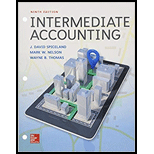
Creating a
• LO4–10
Cadux Candy Company’s income statement for the year ended December 31, 2018, reported interest expense of $2 million and income tax expense of $12 million. Current assets listed in its balance sheet include cash,
| Debt to equity ratio | 1.0 |
| 2.0 | |
| Acid-test ratio | 1.0 |
| Times interest earned ratio | 17 times |
| Return on assets | 10% |
| Return on shareholders’ equity | 20% |
| Profit margin on sales | 5% |
| Gross profit margin (gross profit divided by net sales) | 40% |
| Inventory turnover | 8 times |
| Receivables turnover | 20 times |
Required:
Prepare a December 31, 2018, balance sheet for the Cadux Candy Company.
Ratio analysis
Ratio analysis is a tool to analyze the financial statements of a company which helps to express a mathematical relationship among the items of financial statements.
Balance sheet
This financial statement reports a company’s resources (assets) and claims of creditors (liabilities) and stockholders (stockholders’ equity) over those resources. The resources of the company are assets which include money contributed by stockholders and creditors. Hence, the main elements of the balance sheet are assets, liabilities, and stockholders’ equity.
To prepare: The balance sheet of Company CC for the year ended December, 31 2018.
Explanation of Solution
Prepare the balance sheet of Company CC for the year ended December, 31 2018.
| Corporation CC | ||
| Balance Sheet | ||
| For the year ended December 31, 2018 | ||
| Assets | Amount ($ in millions) |
Amount ($ in millions) |
| Current assets: | ||
| Cash (3) | 10 | |
| Accounts receivables (2) | 20 | |
| Inventories (1) | 30 | |
| Total current assets | 60 | |
| Net property, plant, and equipment (5) | 140 | |
| Total assets | 200 | |
| Liabilities and Shareholders' Equity | Amount ($ in millions) |
Amount ($ in millions) |
| Current liabilities (4) | 30 | |
| Long-term liabilities (7) | 70 | |
| Shareholders’ equity (6) | 100 | |
| Total liabilities and shareholders’ equity | 200 | |
Table (1)
Working notes:
1)
To determine: The amount of net income.
Solution:
Given, Interest expense is $2 and Income tax expense $12
2)
To determine: The average total assets using return on assets ratio.
Solution:
3)
To determine: The amount of net sales.
Solution:
4)
To determine: The gross profit and cost of goods sold.
Solution:
5)
To determine: The amount of average inventory.
Solution:
6)
To determine: The amount of average receivables.
Solution:
7)
To determine: The cash balance.
Solution:
By using the above equation, determine amount of cash.
8)
To determine: The amount of current liabilities.
Solution:
9)
To determine: The amount of non-current assets.
Solution:
10)
To determine: The amount of average shareholders’ equity.
Solution:
11)
To determine: The amount of long-term liabilities
Solution:
Want to see more full solutions like this?
Chapter 4 Solutions
INTERMEDIATE ACCOUNTING(LL)-W/CONNECT
 EBK CONTEMPORARY FINANCIAL MANAGEMENTFinanceISBN:9781337514835Author:MOYERPublisher:CENGAGE LEARNING - CONSIGNMENT
EBK CONTEMPORARY FINANCIAL MANAGEMENTFinanceISBN:9781337514835Author:MOYERPublisher:CENGAGE LEARNING - CONSIGNMENT Financial Accounting: The Impact on Decision Make...AccountingISBN:9781305654174Author:Gary A. Porter, Curtis L. NortonPublisher:Cengage Learning
Financial Accounting: The Impact on Decision Make...AccountingISBN:9781305654174Author:Gary A. Porter, Curtis L. NortonPublisher:Cengage Learning


